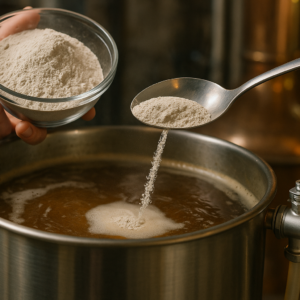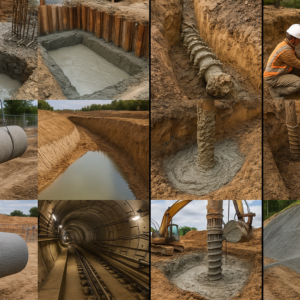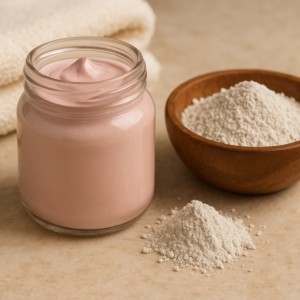When you walk past a high-rise building or drive through a tunnel, you probably don’t think about the clay that made it possible. Bentonite, a natural clay formed from volcanic ash, works behind the scenes in some of the most challenging construction projects. It swells when mixed with water, creating a gel-like substance that solves problems other materials can’t handle.
This unique behavior makes bentonite in civil engineering applications widespread, from stabilizing deep excavations to waterproofing basements. Let’s look at how this clay transforms construction sites and why engineers keep coming back to it.
What Makes Bentonite Special for Construction?
Bentonite consists mainly of montmorillonite, a clay mineral that gives it remarkable properties. When water touches bentonite powder, it can absorb up to ten times its weight and swell to eighteen times its original volume. This creates a thick, stable gel that can support trench walls, seal leaks, and bind materials together.
The clay also has thixotropic properties, meaning it acts like a fluid when disturbed but solidifies when left at rest. This makes it perfect for situations where you need temporary support that won’t flow away. Plus, it’s chemically inactive and non-toxic, so it won’t contaminate groundwater or harm workers.
1. Diaphragm Wall Construction
Deep basement excavations in cities need walls that keep soil and water out. Bentonite slurry makes this possible through a technique called diaphragm walling. Workers dig narrow trenches in sections while filling them with bentonite mixed with water, typically at 4-6% concentration by weight.
The thick slurry exerts hydrostatic pressure on the trench walls, preventing collapse. Steel reinforcement cages get lowered into the slurry-filled trench, then concrete pours in from the bottom through tremie pipes. The heavier concrete pushes the bentonite up and out, where it gets filtered and reused for the next section.
This method built the foundation “bathtub” for the original World Trade Center in 1967-1968 and continues to support major infrastructure projects worldwide. Companies like CMS Industries supply the bentonite powder that contractors mix on-site for these critical applications.
2. Bored Pile Installation
Foundation piles transfer building loads to deeper, more stable soil layers. When drilling these piles, foundry bentonite slurry prevents the borehole from caving in. The slurry also lubricates the drilling equipment and carries drill cuttings to the surface. As drilling progresses, fresh foundry bentonite slurry circulates through the hole.
It forms a thin filter cake on the borehole walls that reduces water seepage into the excavation. Once the pile reaches design depth, workers place the reinforcement cage and pour concrete while the slurry provides continuous support. This application works in various soil types, from soft clays to harder formations. The foundry bentonite slurry keeps the hole stable until the concrete sets, creating a solid foundation element.
3. Tunneling Support
Underground rail lines and road tunnels require careful excavation without disturbing surrounding soil. Bentonite slurry in civil engineering projects serves multiple functions here. In shield tunneling operations, the slurry supports the excavation face in front of the cutting tools.
The thixotropic bentonite holds back groundwater and prevents soil from flowing into the work area. It also transports excavated material to separation equipment at the surface. The slurry maintains wall stability while workers install permanent tunnel linings.
Bentonite mats or panels can line finished tunnel walls to create waterproof barriers. When groundwater tries to pass through, the bentonite swells and blocks the flow path.
4. Waterproofing Applications
Basements, underground parking structures, and below-grade walls face constant water pressure. Bentonite provides a self-healing waterproofing solution. When installed as sheets or panels against foundation walls, the clay remains dormant until water appears.
Moisture triggers the bentonite to expand, filling cracks and gaps automatically. This creates an impermeable barrier that adjusts to minor structural movements over time. Unlike synthetic membranes that can tear or degrade, bentonite maintains its sealing ability for decades.
The material works equally well on horizontal surfaces like basement floors. Contractors can apply bentonite slurry directly to surfaces or install it as part of composite waterproofing systems.
5. Soil Mixing and Stabilization
Weak or compressible soils need reinforcement before construction can begin. Deep soil mixing combines bentonite with cement and excavated soil to create strong, water-resistant columns or walls. Equipment injects the mixture at depth while rotating mixing blades blend it with native soil.
The resulting soil-bentonite or cement-bentonite columns form a continuous barrier that blocks water movement. This technique works well beneath dams, around contaminated sites, or anywhere groundwater control matters.
Bentonite stabilizes soil by filling voids between particles and improving the soil’s load-bearing capacity. The clay binds to soil particles through ion exchange, creating a more cohesive mass.
6. Cutoff Walls for Water Control
Dams, levees, and water retention structures need impermeable barriers to prevent seepage. Bentonite cutoff walls create this barrier by excavating a trench and backfilling it with soil-bentonite or cement-bentonite mixture.
The construction process starts with trenching equipment working through bentonite slurry. The slurry prevents collapse while workers excavate to the required depth, often reaching bedrock. Then they backfill the trench with a mixture designed to harden into a permanent water barrier.
These walls have permeability values low enough to stop water migration through soil, sand, or gravel formations. They protect against contaminants leaching from landfills and prevent groundwater from flooding excavations.
7. Geosynthetic Clay Liners
Modern waterproofing often uses geosynthetic clay liners (GCLs), which sandwich bentonite between layers of geotextile fabric. This creates flexible mats that contractors can roll out and install quickly.
The fabric provides tensile strength and protection while the bentonite core delivers the waterproofing. When water reaches the GCL, the bentonite swells within its fabric envelope, creating an effective seal. CMS Industries manufactures bentonite grades specifically designed for GCL applications, meeting strict quality standards for particle size and swelling capacity.
These liners work in landfill bases and caps, containment ponds, canal linings, and beneath building foundations. They combine the self-healing properties of bentonite with the handling benefits of a manufactured product.
8. Grouting and Sealing
Small cracks, fissures, and joints in concrete or rock need sealing to prevent water infiltration. Bentonite grout provides a flexible, permanent solution. Workers inject the clay slurry under pressure into voids where it expands and hardens.
This application suits situations where cement grout won’t work because the gaps are too small or the surrounding material might shift. The bentonite adjusts to minor movements without losing its seal.
Grouting also lubricates pipes during installation through soil. The slurry reduces friction between the pipe surface and surrounding earth, making it easier to push or pull pipes into position.
9. Drilling Mud for Soil Investigation
Before construction begins, engineers need to understand subsurface conditions. Geotechnical borings extract soil samples for testing, and bentonite drilling mud makes this possible. The mud cools and lubricates the drill bit while carrying cuttings to the surface.
More importantly, it maintains borehole stability in loose or saturated soils. The bentonite forms a filter cake on the borehole wall that prevents caving and reduces fluid loss into permeable formations.
This same principle applies to water well drilling, mineral exploration, and geothermal well installation. The mud properties can be adjusted by changing the bentonite concentration to match specific soil conditions.
10. Concrete Performance Enhancement
While less common than other uses, small amounts of bentonite can improve concrete mixtures. Adding bentonite at low percentages increases workability, reduces segregation, and improves water retention during curing.
The clay particles fill microscopic voids in the concrete matrix, potentially reducing permeability. This can benefit concrete exposed to water pressure or aggressive environments.
Some specialized concrete applications use bentonite as a plasticizer or to control bleed water. The amounts are carefully controlled since too much bentonite can reduce concrete strength.
Environmental Benefits of Bentonite
Civil engineering bentonite offers sustainability advantages over synthetic alternatives. As a naturally occurring material, it requires minimal processing compared to chemical compounds, and its mining and manufacturing processes have a much smaller carbon footprint than producing plastic membranes or chemical grouting agents.
The clay is reusable in many applications. Bentonite slurry from diaphragm wall construction can be filtered, tested, and used again on the same project. At the end of its service life, bentonite breaks down naturally without leaving toxic residues.
Its long-term performance means structures need fewer repairs and replacements. A properly installed bentonite waterproofing system can last as long as the building itself, reducing maintenance costs and material consumption over time.
How to Choose Quality Bentonite
Not all bentonite performs equally in construction. Sodium bentonite swells more than calcium bentonite and works better for most civil engineering uses. The montmorillonite content should exceed 85% for applications requiring high swelling capacity.
Particle size distribution affects how easily the bentonite mixes and how well it forms filter cakes. Suppliers like CMS Industries test each batch for key properties including viscosity, gel strength, and fluid loss characteristics.
Projects should specify bentonite meeting recognized standards for the intended application. Testing the slurry on-site ensures it maintains proper properties throughout construction. Simple field tests measure density, viscosity, and sand content to verify quality.
Common Challenges and Solutions
Bentonite performance depends on proper mixing and handling. Powder added too quickly to water forms lumps that don’t fully hydrate. Using a venturi hopper or high-shear mixer ensures thorough dispersion.
Salt water destroys bentonite’s swelling ability and should never be used for mixing. If water quality is questionable, testing determines whether treatment is needed before mixing.
Temperature affects bentonite behavior. Cold weather slows hydration and may require longer mixing times or heated water. Hot weather increases water loss through evaporation, so contractors need to monitor slurry properties more frequently.
Future Developments
Research continues into modified bentonites with enhanced properties for specific applications. Polymer-enhanced bentonites offer some advantages over traditional formulations, though pure bentonite remains the standard for most work.
Better testing methods help engineers predict bentonite performance more accurately. Real-time monitoring systems track slurry properties during construction, alerting operators to problems before they affect the work.
As construction projects become more complex and environmental regulations stricter, bentonite’s role will likely expand. Its combination of performance, cost-effectiveness, and environmental compatibility makes it well-suited for future infrastructure needs.
Frequently Asked Questions
Q1: What is bentonite and why is it used in construction?
Bentonite is a natural clay that swells when mixed with water, forming a thick gel. Construction projects use it to stabilize excavations, prevent water infiltration, and create impermeable barriers. Its unique swelling properties and low permeability make it better than alternatives for supporting trenches, waterproofing foundations, and controlling groundwater around construction sites.
Q2: How does bentonite slurry prevent trench collapse?
Bentonite slurry exerts hydrostatic pressure against trench walls, counteracting the inward pressure from surrounding soil and groundwater. The thick fluid acts like a liquid support system. It also forms a thin filter cake on the soil surface that reduces water seepage and helps stabilize the excavation until permanent structures are installed.
Q3: Can bentonite be reused during construction?
Yes, bentonite slurry can be filtered, tested, and reused multiple times on the same project. After concrete displaces slurry from a diaphragm wall panel, contractors pump it into storage tanks, remove drill cuttings and debris through filtration, and check its properties. If viscosity and density meet specifications, the slurry goes back into service.
Q4: What’s the difference between sodium and calcium bentonite?
Sodium bentonite swells significantly when wet, making it ideal for waterproofing, drilling mud, and excavation support. Calcium bentonite has lower swelling capacity but stronger binding properties, so it works better in some soil stabilization applications. Most civil engineering projects specify sodium bentonite because of its superior sealing and support capabilities.
Q5: How long does bentonite waterproofing last?
Properly installed bentonite waterproofing can last for the life of a structure, often 50 years or more. Unlike synthetic membranes that degrade or tear, bentonite maintains its properties indefinitely when protected from freezing while dry. It’s self-healing, so minor building settlements or cracks don’t compromise the waterproof barrier as the clay swells to fill any gaps.







